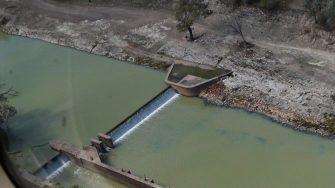
Date: Thursday, October 12, 2017
Project: Eastern Australian Waterbird Survey
We have begun to behave like the water birds we count. Today we followed the rain front which passed through White Cliffs last night, wakening us with its intense but pounding of the galvanised roof of the White Cliffs Hotel.
As our plane moved faster than the rain front we had to rest in Bourke for a couple of hours to let it get well ahead so that cloud cover was not an issue as we approached Armidale from the west. On the way into Bourke we surveyed the Darling River which has a low flow. The local weir assists in keeping the river level raised in the vicinity of the town.
Photos: Terry Korn
Our route was highlighted by wet clay pans and flowing gullies but many paddocks signalled the drought with their golden circles of hay straw where round bales have been consumed by sheep and cattle. In a few weeks they may have long awaited green feed if a hot spell doesn’t burn it off.
What was the highlight today? Undeniably it was seeing the Macquarie Marshes with a good amount of water and the excitement of Ibis in particular as they think about breeding in small numbers in the more permanent swamps. Some White Ibis were starting to trample a few lignum bushes in one of the northern swamps, but no nests could be seen.
The wet Macquarie Marsh was in contrast to the wonderful Paroo wetlands we flew this morning. They are dry, except for part of one of the larger wetlands, although one could have easily been deceived by the glint of storm water in each depression in the early morning sunlight. Salt lakes in particular are very deceptive under such conditions as they behave like mirrors.
Photo: Terry Korn
As we neared the mountains south east of Narrabri we encountered the large Maule’s Creek coal mine.
